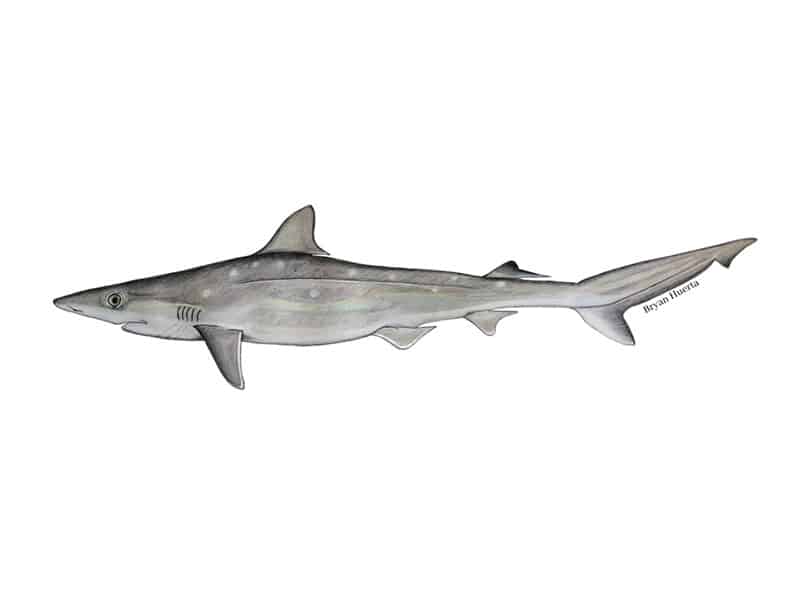
Press Release: JAW STUDY HELPS REVEAL HIDDEN SECRETS OF ATLANTIC SHARPNOSE SHARKS
Birmingham, AL (April 12, 2023) – Today, a team of scientists announced their findings of a multi-year study of the dentition of Atlantic Sharpnose Sharks from the northern Gulf of Mexico.
“By gaining a better understanding of the teeth and dentitions of this species, it allows us to identify potential ancestors of this shark in the fossil record,” said study lead, Jun Ebersole, Director of Collections at McWane Science Center in Birmingham, AL. “This in turn, helps us gain a better understanding of how this particular shark lineage evolved through time and adapted to global events like climate change.”
Other scientists on the study include, Abigail Kelosky, Aquarist at McWane Science Center; Bryan Huerta-Beltrán, MS student in the School of Biological, Environmental, and Earth Sciences at the University of Southern Mississippi, Hattiesburg; David Cicimurri, Curator of Natural History at the South Carolina State Museum in Columbia; and Marcus Drymon, Assistant Extension Professor at the Coastal Research and Extension Center at Mississippi State University, Biloxi.
Known scientifically as Rhizoprionodon terraenovae, Atlantic Sharpnose Sharks are the most common coastal requiem shark in the northern Gulf of Mexico.
“While there is a great deal known about the life history, habitat preference, diet, and movement of these small sharks in this region, very little is known about their teeth and dentition,” Drymon said.
According to Huerta-Beltrán, “it has been well-documented that these sharks go through a dietary change as they grow, with newborns generally feeding on shrimp and squid before transitioning to a more fish-reliant diet as they mature.”
The team hypothesized that this change in diet would be reflected in the teeth of various sized sharks. To account for potential dental differences between sexes and growth stages, 126 sets of jaws were examined, including males and female sharks of various size classes, from mature adults, to immature, new-born, and even unborn pups.
“Because sharks have a unique adaptation where they continually replace their teeth, with some species able to shed and replace an estimated 20,000 to 30,000 teeth in their lifetime, most shark species evolved very specialized dentitions that were adapted to their specific diets,” Drymon said.
“The change in Atlantic Sharpnose Shark tooth morphology was quite drastic,” Kelosky said. “We were able to document how the teeth acquired serrations over time, essentially transforming from a smooth-edged butter knife, to a sharp and serrated steak knife as the shark matured.”
“The changes occurred precisely at the growth stage where the sharks became more reliant on fishes as part of their diet, indicating that the serrated teeth helped these sharks better feed on these more-fleshy prey items,” Kelosky continued.
In addition to a dietary function, the study discovered an unexpected finding related to breeding.
“It had been thought for decades that there was no difference between male and female Atlantic Sharpnose Shark teeth, but in this study, we discovered just the opposite,” Ebersole said.
“In mature male individuals, we noticed that some of the lower teeth transformed from flat steak knives to tall cylindrical needles, and that this change happened to correspond with the breeding season of the sharks in this area,” Ebersole continued. “It appears that males develop these needle-like teeth to grab onto the female during mating, and after the breeding season, these specialized teeth are replaced with serrated ones.”
According to Cicimurri “only about half of the sharks and rays living today have a fossil record, meaning, most species have yet to be identified as fossils, which is in part due to our lack of knowledge of living shark jaws and teeth – without which, we cannot accurately identify sharks and rays in the fossil record.”
After examining fossil teeth from around the world, the team was able to identify several ancient species of sharpnose sharks.
“These were likely direct ancestors to the Atlantic Sharpnose Shark,” Cicimurri said.
“Sharpnose sharks appear in the fossil record approximately 55-million-years ago, with the oldest ones being recently discovered in Alabama and Mississippi,” Cicimurri continued. “Although not definitive, this suggests that sharpnose sharks may have originally evolved in the ancient Gulf of Mexico.”
The study, titled Observations on heterodonty within the dentition of the Atlantic Sharpnose Shark, Rhizoprionodon terraenovae (Richardson, 1836), from the north-central Gulf of Mexico, USA, with implications on the fossil record, was published today in the journal PeerJ. https://peerj.com/articles/15142/#
Image captions:
Image 1: Illustration of an Atlantic Sharpnose Shark (Rhizoprionodon terraenovae). Image courtesy of Bryan Huerta-Beltrán.
Image 2: Abigail Kelosky, Aquarist at McWane Science Center, examining an Atlantic Sharpnose Shark jaw. Photo courtesy of McWane Science Center in Birmingham, AL.
Image 3: Atlantic Sharpnose Shark teeth. Image courtesy of PeerJ.
Media Contacts:
Miranda Springer
Vice President of Development and Marketing
McWane Science Center
200 19th Street North
Birmingham, AL 35203
(205)714-8219
Jun Ebersole
Director of Collections
McWane Science Center
200 19th Street North
Birmingham, AL 35203
(205)714-8347
Marcus Drymon
Assistant Extension Professor
Mississippi State University
Mississippi-Alabama Sea Grant Consortium
1815 Popps Ferry Road, Biloxi, MS 39532
(228)546-1028


